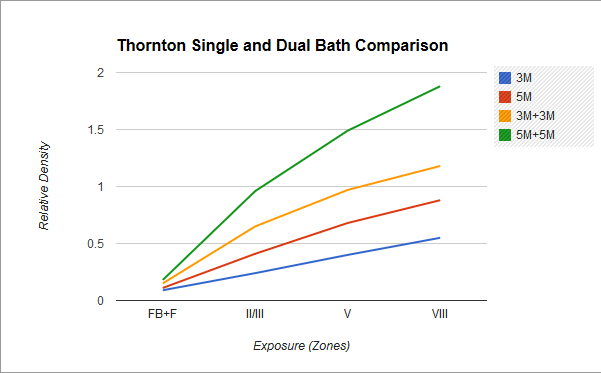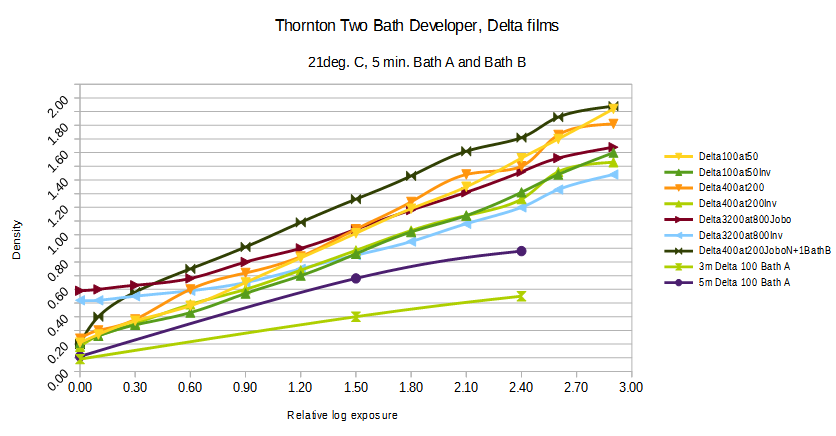Thornton Two Bath Developer
This film developer is a reformulation of the Stoeckler formula by the late Barry Thornton. Like all developers, it seems to gain adherents with the same partisanship as major sports teams. I am not sure why. It is not magic, but it is a simple and comparatively foolproof introduction to mixing your own developer.
This is not strictly a two bath developer, since the first bath is sufficiently alkaline that some development occurs in the first bath. The second bath is an alkaline accelerator, and is intended to increase density in the shadows while providing some compensation against excessive highlight density. This adds an extra variable to the usual time, temperature, agitation, and concentration. In principle the second bath works with the developer absorbed in the film emulsion at the end of the first bath, and that developer is exhausted rapidly in the highlight areas, while continuing to work in the shadows to improve density.
This makes one big assumption, namely that the amount of developer on the surface of the film and carried over on the tank surfaces is either a negligible factor, or an effective constant. The film emulsion should be saturated with Bath A at the start of the second phase. The acceleration of the alkaline bath B will take effect as the bath B diffuses into the emulsion. The residual Bath A in the emulsion will either be exhausted by reducing the silver halides, or will gradually diffuse out into the bulk of bath B. So either the residual bath A is exhausted, or it is diluted to a level where it becomes ineffective over any reasonable time period.
Agitation does play a significant role in the behavior of the developer. Using a Jobo CPE2+ (75rpm, 1520 tank, 21 degrees Celsius), the maximum density for Delta 100 at EI50 was 1.9. Using the same tank, but inverting every 60 seconds after an initial 15 second inversion gave a maximum density of 1.60. Jobo recommends a pre-wash with plain water prior to development, and retaining normal inversion timings with most developers. Since the Thornton developer is usually treated as a reusable stock, this could lead to a slight dilution over time, so the pre-wash should be omitted. On the other hand, the saturated emulsion will delay the initial take up of the developer, and offset the effect of the continuous agitation/partial submergence of the Jobo rotary tanks. Since the use of a pre-wash has always been debated among Jobo users (some swear by it, others swear at it), it seems wiser to forgo a pre-wash and accept different times for Jobo and inversion processing when using this developer.
The capacity is normally given as 10-15 35mm 36 exposure films (about the same in 120 roll film, and 30-45 sheets of 5x4 film). In practice, the losses to Bath A from film absorption and carry-over to Bath B will reduce the volume of the stock Bath A. I usually mix up fresh developer once the volume has dropped to 600-700 ml. The Jobo needs at most 600ml of chemistry, so this works out nicely. The sodium metaborate is self-buffering and will normally maintain its alkalinity for the life of Bath A. Again, I usually mix up fresh Bath B whenever I do Bath A.
Developing times are around 5 minutes in each bath for faster films, 4 minutes for medium to slow films. Most people seem to use the same time in each bath, but Bath B times probably should not be cut too short. There are claims that this developer is not too sensitive to temperature variations. Personally I aim for 21 degrees Celsius every time.
Compensation effects are most apparent when the agitation is periodic, especially with Bath B. I normally use a Jobo processor, but even then the highlights hold detail well. Experimentation is the key.

This graphic shows the density against exposure curves for Ilford Delta 100 (EI 50, 21 degrees Celsius) for Bath A at 3 and 5 minutes, and both baths at 3 and 5 minutes. Measurement was done using a transmission densitometer using a grey card subject for Zone V (meter point), a black card for Zone II and a half, and a white card for Zone VIII. The Zone differences were determined using a spot meter.
The density and contrast effects from using the second bath are apparent.

Here are more detailed curves for Delta 100, Delta 400, and Delta 3200. Exposure Indices were Delta 100 at 50, Delta 400 at 200, and Delta 3200 at 800. The 3minute and 5 minute Delta 100 measurements from the preceding graph are included for comparison.
The inversion agitation curves (labeled ‘Inv’ in the legend), used 15 seconds continuous inversion at the start of development, then one inversion every minute. The difference in density compared to the Jobo data is apparent. The maximum density measured for Delta 400 was approximately 1.50 for inversion, and 1.80 for the Jobo. For Delta 100 the difference is 1.70 to 1.90. So agitation is definitely significant. One would expect more or continuous agitation in Bath A to increase the basic density, while reducing agitation in Bath B (to maybe initial inversion plus one inversion every two minutes) would increase the compensation effect.
Another interesting comparison is between the Delta 400 at 200 line, and the Delta 400 at 200 Jobo N+1 Bath B line. Both are run on the Jobo, but the N+1 line uses a 20g/litre sodium metaborate Bath B. Using the Jobo with continuous agitation, the stronger Bath B has increased the overall density and flattened the mid-range.
I have no explanation for the dip in the curves at 2.40 relative log exposure. I suspect it may be an indication of non-linear response in my densitometer when changing scales, though it has been verified against a step wedge.
At this point it is not clear how long it takes for Bath B to become largely ineffective. Further tests at 7 and 10 minutes in Bath B are indicated. Bath A should be a viable developer in its own right. Times should fall somewhere between those for D23 at 1+1 and 1+3, say between 10 and 12 minutes at 21 C.
Update April 2019 - Bergger Panchro 400 sheet film
Bergger has had 8x10 sheets out for a while now, and at a competitive price. It is a dual layer film, and seems to behave differently in Thornton Two Bath than expected. My initial tests using the 6+6 times I use for Ilford HP5 gave a very thin negative. The published D-76 1+1 time is 17 minutes and the stock time as 9 minutes, so I tried 17 minutes in Bath A + 6 minutes in Bath B, with a 3 minute pre-wash. EI 200, 21 C., Jobo CPE2+, 2830 Drum.
This gave FB+F of 0.32, Zone III of 0.76, Zone V of 1.19, and Zone VIII of 1.77 (the Zone levels include FB+F). These values are not too different from Delta 100 at 5+5. That is about 4.8 stops from FB+F to the VIII Zone exposure. It may be that the 17 minutes in Bath A is too much, but this film definitely wants longer development.
References:
Formula
Bath A
- Water 750ml
- Metol 6.5g
- Sodium Sulphite 80g
- Water to make 1 litre
The usual pinch of sodium sulphite before dissolving the metol applies, otherwise dissolve in the order given. Warm but not hot, distilled water will help the metol dissolve. There is an older variant that uses 6.25g of metol to 85g sodium sulphite.
Bath B
- Water 750ml
- Sodium metaborate 12g
- Water to make 1 litre
Use undiluted, and recover. No intermediate rinse. Capacity ~ 10 35mm/36 exposure films or equivalent area. From: Edge of Darkness, Thornton B., Amphoto 2001, ISBN 0-8174-3815-7.